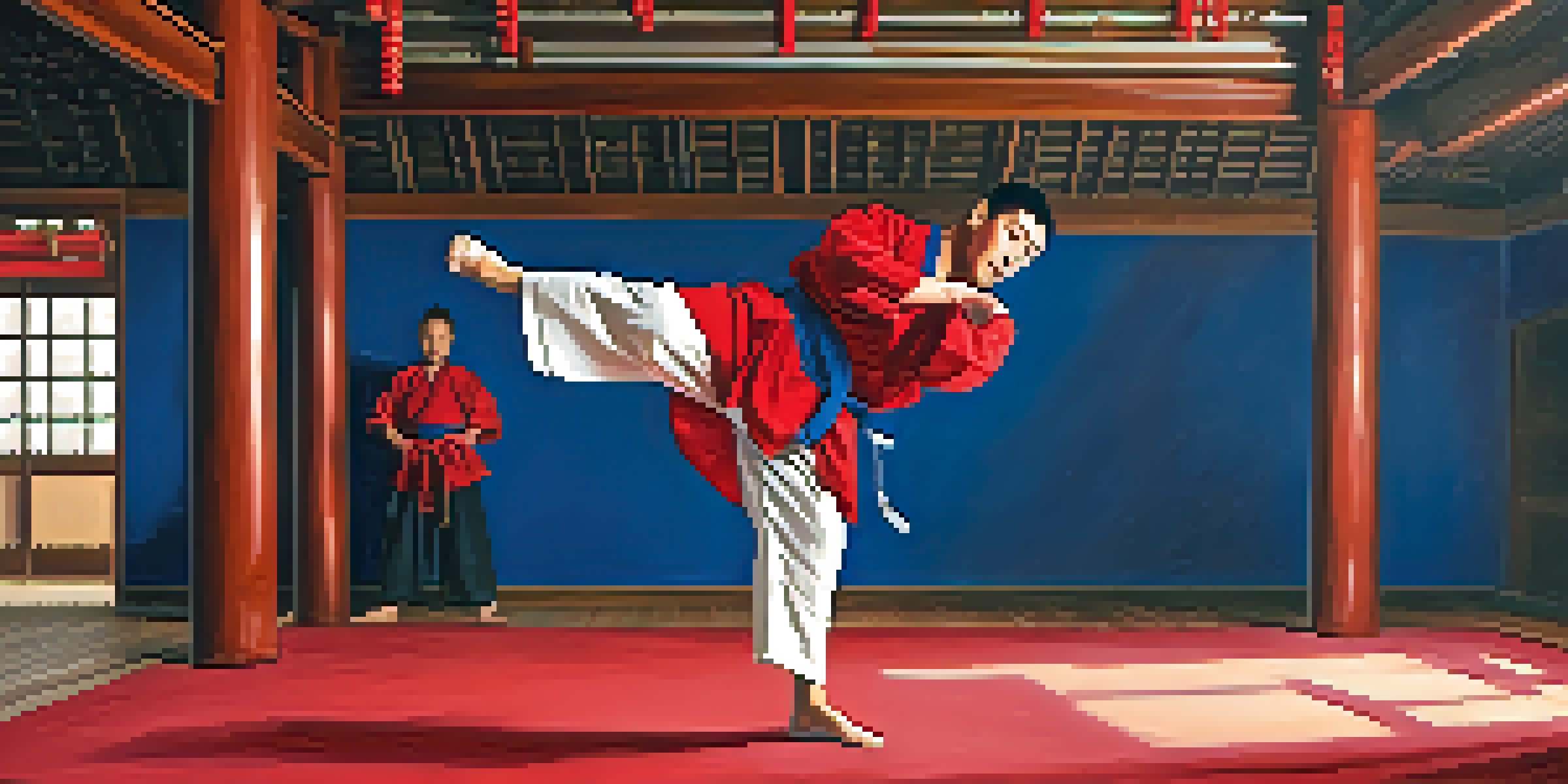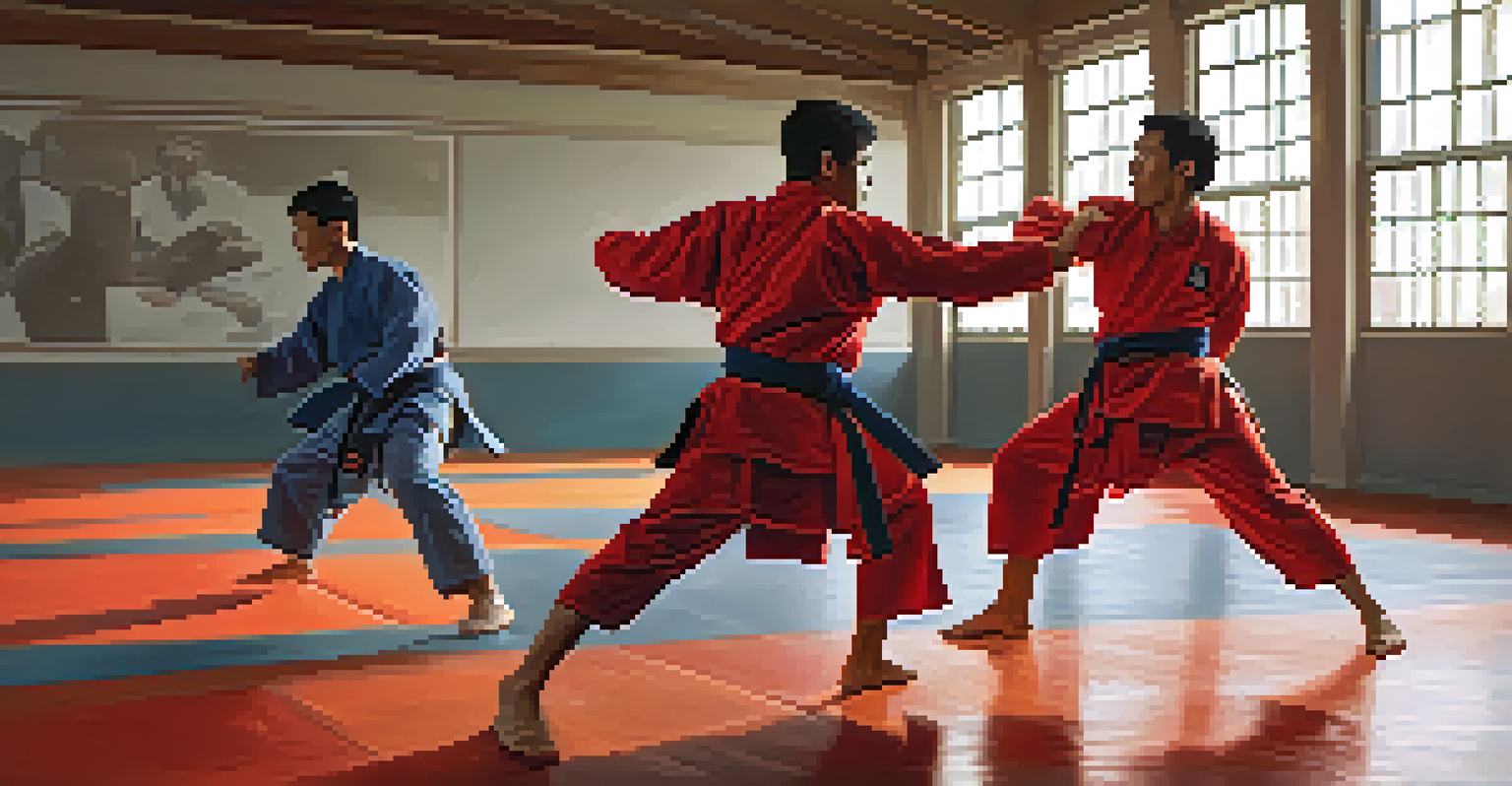Sambo: Techniques and History of a Unique Russian Martial Art

The Origins of Sambo: A Historical Overview
Sambo, a martial art that combines elements of judo and wrestling, originated in Russia in the early 20th century. It was developed by the Soviet military to enhance hand-to-hand combat skills among soldiers. The name 'Sambo' is derived from the Russian acronym for 'Self-Defense Without Weapons'. This unique art form has evolved over the decades, reflecting the cultural and historical shifts within Russia itself.
The greatest victory is that which requires no battle.
In the 1930s, Sambo began to gain popularity as a sport, with its first national championship held in 1938. The discipline was structured to include various techniques, focusing on throws, ground control, and submission holds. Notably, it was designed to be accessible, allowing practitioners from different backgrounds to participate and benefit from its teachings.
The blend of various martial arts techniques in Sambo not only made it effective but also contributed to its growth on an international scale. By the mid-20th century, Sambo had garnered attention beyond the Soviet Union, leading to its inclusion in various competitions and tournaments worldwide.
Key Techniques in Sambo: An Overview
Sambo is known for its diverse range of techniques that include throws, joint locks, and ground grappling. One of the hallmark techniques is the 'hip throw,' which allows practitioners to leverage their opponent’s weight against them. This technique exemplifies the principle of using an opponent's momentum to gain control, a fundamental aspect of Sambo.

Another vital component of Sambo is its focus on submissions, such as arm bars and chokes. These techniques are designed to incapacitate an opponent quickly and decisively. Practitioners often train in both standing and ground positions, ensuring they are well-prepared for any scenario that may arise during a match.
Sambo's Historical Roots
Sambo originated in early 20th century Russia as a military training method, blending judo and wrestling techniques.
Moreover, Sambo emphasizes the importance of adaptability and improvisation. Unlike more rigid martial arts, it encourages practitioners to think on their feet and modify techniques to suit the situation at hand. This flexibility is what makes Sambo not just a sport but a valuable self-defense system as well.
The Role of Sambo in Modern Martial Arts
In recent years, Sambo has gained recognition as a competitive sport and a valuable training tool for mixed martial arts (MMA) fighters. With its effective grappling techniques and striking elements, many fighters incorporate Sambo into their training regimens. This has led to an increase in Sambo’s visibility in the global martial arts community.
In the middle of difficulty lies opportunity.
Sambo's principles of leverage and technique over brute strength resonate well with the evolving nature of combat sports today. As fighters seek to enhance their skills, many are turning to Sambo for its practical applications and efficient techniques. This cross-training approach not only broadens their skill set but also enriches the overall quality of competition.
Additionally, the rise of Sambo competitions worldwide has fostered a sense of community among practitioners. Events bring together enthusiasts from diverse backgrounds, promoting a shared passion for the art. This camaraderie highlights Sambo's role not just as a sport, but as a means of building connections and fostering respect among martial artists.
Sambo's Cultural Significance in Russia
Beyond its technical aspects, Sambo holds a significant place in Russian culture and history. It represents a fusion of traditional martial arts with modern combat training, reflecting the resilience and creativity of the Russian people. Sambo has often been a symbol of national pride, especially during international competitions where Russian athletes showcase their skills.
The cultural significance of Sambo is also evident in its portrayal in Russian media and literature. Documentaries, films, and books often highlight the discipline as a reflection of Russian strength and determination. This portrayal helps to inspire new generations of practitioners who see Sambo not just as a sport, but as a cultural heritage.
Two Main Styles of Sambo
The two primary styles of Sambo are Sport Sambo, focused on competition, and Combat Sambo, which includes striking for practical self-defense.
Furthermore, Sambo has become a vehicle for promoting fitness and self-discipline among youth in Russia. Many schools and community centers offer Sambo classes, encouraging young people to engage in physical activity and learn valuable life skills. This commitment to youth development through martial arts underscores the enduring legacy of Sambo in Russian society.
Popular Sambo Styles: Sport and Combat Sambo
There are two main styles of Sambo: Sport Sambo and Combat Sambo. Sport Sambo focuses on competition and is similar to judo, emphasizing throws and grappling without strikes. This style is often showcased in tournaments and is popular among those who enjoy the competitive aspect of martial arts, allowing athletes to test their skills in a structured environment.
Combat Sambo, on the other hand, incorporates strikes, making it a more comprehensive form of self-defense. This style is particularly appealing to military and law enforcement personnel who require practical skills for real-world scenarios. Combat Sambo training includes techniques for both armed and unarmed combat, preparing practitioners for a variety of situations.
While both styles share foundational techniques, the choice between Sport and Combat Sambo often depends on the individual’s goals. Whether one seeks competition or practical self-defense, both styles offer unique benefits and a deep understanding of the martial art's principles.
Training in Sambo: What to Expect
Training in Sambo typically involves a combination of drills, sparring, and technique refinement. Beginners often start with fundamental movements and basic techniques, gradually progressing to more complex maneuvers as they build confidence and skill. This structured approach ensures that practitioners develop a solid foundation before advancing.
Classes often emphasize physical conditioning, as strength, speed, and endurance are crucial components of effective Sambo practice. Practitioners engage in various exercises designed to enhance their overall fitness, making training both physically demanding and rewarding. The camaraderie among participants fosters a supportive training environment, where everyone encourages each other to improve.
Sambo's Global Growth
With increasing international interest and competitions, Sambo is expanding its reach and fostering a sense of community among practitioners worldwide.
Moreover, the mental aspect of training is equally important in Sambo. Practitioners learn to strategize and think critically about their movements, developing a deeper understanding of the art. This mental engagement, paired with physical practice, creates a comprehensive training experience that not only builds martial skills but also instills discipline and focus.
Sambo's Future: Growth and Globalization
As interest in martial arts continues to grow globally, Sambo is poised for further expansion. With more schools and clubs introducing Sambo to their curricula, the art is reaching new audiences worldwide. This increasing accessibility is essential in fostering a new generation of practitioners who can carry on the tradition.
International competitions and events dedicated to Sambo are also on the rise, showcasing the discipline's unique techniques and fostering a sense of unity among practitioners. These gatherings not only promote healthy competition but also serve as seminars for sharing knowledge and skills, enhancing the global Sambo community.

Looking ahead, the future of Sambo appears bright, as it continues to adapt and evolve. With its rich history and effective techniques, Sambo will likely remain a respected martial art, appealing to both traditionalists and modern combat sports enthusiasts alike. As more individuals discover the benefits of Sambo, its legacy will undoubtedly endure for years to come.